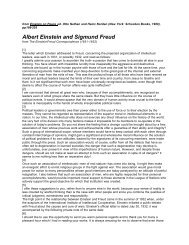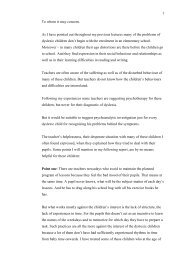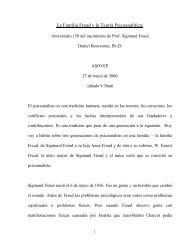Crisis Intervention After Major Disasters
Crisis Intervention After Major Disasters
Crisis Intervention After Major Disasters
You also want an ePaper? Increase the reach of your titles
YUMPU automatically turns print PDFs into web optimized ePapers that Google loves.
<strong>Crisis</strong> <strong>Intervention</strong><strong>After</strong> <strong>Major</strong> <strong>Disasters</strong>By Daniel Benveniste, Ph.D.In this article the author presents a brief description of acute stress disorders anddescribes some early intervention strategies for working with traumatized adults andchildren in the immediate aftermath of a major disaster. It was written in response to theDecember 1999 floods that devastated much of Venezuela, killed 50,000 people and left500,000 homeless and psychologically traumatized. The content of the article wasoriginally presented in a lecture format for professionals and lay people who went out towork with the survivors in the shelters. It was then written in English, translated intoSpanish, distributed to counselors in the shelters in Caracas, and sent out on the Internetto mental health professionals across the country. Though it was written for mental healthprofessionals working with victims of the Venezuelan floods, it will hopefully be usefulto other mental health professionals, in the future, working with survivors of a wide rangeof major disasters.WHAT IS A PSYCHOLOGICAL CRISIS?A psychological crisis comes about when a traumatic event overloads a person’s capacity to cope in his orher usual fashion. Psychological crises cannot reliably be predicted based on the events that precede them.An event that precipitates a psychological crisis for one person is not necessarily going to precipitate acrisis for another person. Nonetheless, some events commonly precipitate psychological crisis reactions.These include physical assaults, torture, rape, automobile accidents, intense personal losses, and naturalcatastrophes such as earthquake, fire and flood. Events like these will often induce a psychiatric disorderthat we call an ACUTE STRESS DISORDER. The Acute Stress Disorder is characterized by feelings ofintense fear, helplessness and horror. There may also be an emotional numbing, a lack of emotionalresponsiveness, a feeling of detachment, reduced awareness of surroundings, a sense of unreality oramnesia. People suffering an Acute Stress Disorder may feel anxious, excitable, agitated, distressed,despairing, irritable, or hopeless. They may re-experience the event in recurring dreams, flashbacks, orpersistent memories of the trauma. The person may avoid people, places and objects that may re-awakenmemories of the traumatic event. They may have difficulty concentrating and may have difficultyfunctioning in their usual way at home and at work. They may also suffer survivor guilt or guilt for notproviding enough help to others. Some people may become aggressive or self destructive, disregard selfcare,become confused or behave in a bizarre fashion.When dealt with quickly, the symptoms of Acute Stress Disorder will typically diminish or disappearentirely within 30 days. In some cases, particularly when untreated, Acute Stress Disorder may persist. Ifits duration is from one to three months we call it an ACUTE POSTTRAUMATIC STRESS DISORDER.When the symptoms last more than three months, we call it a CHRONIC POSTTRAUMATIC STRESSDIORDER. (The above diagnostic information is derived from the DSM-IV, 1994) It is not uncommon foruntreated Posttraumatic Stress Disorder symptoms to persist for many years and become serious constraintson a person’s life. It is also important to remember that when a person struggles with a severe stressreaction, it is likely that the family or any other people around the patient will also be affected by thesymptoms of the patient’s Post Traumatic Stress Disorder.WORKING WITH ACUTE AND POST TRAUMATIC STRESS DISORDERED PATIENTSCounselors working with Acute and Posttraumatic Stress Disordered patients may assist them in themanagement of the post-traumatic event tasks (informing others, making calls, rescheduling the person’sdaily routine), and providing a safe place to talk about either the event, the person’s symptoms, or whateverelse is foremost on the patient’s mind. Though it is sometimes initially painful to talk about the traumaticevent, people often report a sense of relief and a reduction of symptoms after they have been able to talkabout the event. They can see the situation more clearly after putting the pieces of the problem out on the1
nature of the emergency and the need for support from others. Office hours in a crisis have nothing to dowith the clock. The counselor meets with people when they are in need. Sessions last as long as the needsand resources allow them to last.6) COUNSELORS WORKING IN A CRISIS NEED TO BE LIGHT ON THEIR FEET.They need to leave the private practice model behind and even leave the clinic model behind. They need tolook at the situation for what it is and be as creative and innovative as they can. They need to improvisewith space, time, materials and resources. They need to collaborate closely with others. They need to assesstheir task and choose goals appropriate to the circumstances and the situation. They need to be forgiving ofothers and themselves when they lose their composure. And, if at all possible, they need to maintain theirsense of humor.CRISIS INTERVENTIONThe crisis intervention setting is different from a clinic setting. The counselor may be in a school or achurch, in a field or under a tree. And just as the crisis intervention setting is different from a clinic, so tooare the problems the crisis counselor deals with. The problems include the kinds of symptoms describedabove in the section describing ACUTE STRESS DISORDER. During the crisis the goal of treatment is notcharacterological change, or insight into the childhood origin of the patient’s problems.The goal of crisis intervention is to help the patient to COPE with the trauma.The goal is to help the patient ADJUST to the new situation.The goal is to RETURN THE PATIENT TO THE PREVIOUS LEVEL OF FUNCTIONING.These goals are met by inviting the patient to talk about his or her experiences, get some perspective on theevent, sort out the associated feelings, and problem solve about how to deal with his or her problems.FIRST CONTACTIn the first contact it will be useful to get a little bit of information like the person’s name, medicalcondition, social support system, etc. but the crisis patient should not be subjected to a lengthy intakeevaluation. The counselor should try to set the patient at ease, clarify the task and invite the patient to talk.A good crisis counselor is a good listener but the crisis counselor is often more active than apsychotherapist who sees patients on an on-going basis. The crisis counselor clarifies, reassures, educates,offers advice about practical matters that the patient needs to deal with, and refers patients to appropriateagencies and programs. The counselor needs to be very mindful of the patients medical condition, seekmedical consultations about any concerns they may have and refer patients for medication consultationswhenever anxiety, depression, agitation or sleeplessness are at levels that severely impair functioning ormake the crisis intervention impossible.LONG AND SHORT TERM GOALSIn the midst of a crisis, people lose perspective. They are flooded with thoughts and feelings. They havedifficulty setting priorities and as a result they tend to get very concerned about things they can’t deal withand tend to avoid or ignore the more immediate concerns of the moment that they can deal with. For thisreason it is often useful to help the patient to organize their thoughts into two sets of goals - a set of shorttermgoals and a set of long term goals. SHORT TERM GOALS include calming down, trying to come toterms with their intense fear, talking about what has just happened to them, getting shelter for the night,having something to eat, etc. LONG TERM GOALS include getting into a long-term therapy, looking for ajob, finding permanent housing, etc. The crisis counselor needs to be very ACTIVE and DIRECTIVE inhelping the patient sort out these two types of goals and then in attending, in a very practical way, toachieving the short term goals and making a plan to attend to the long term goals.MAKING A PLANPeople in crisis have trouble concentrating, thinking straight, using good judgment, and setting priorities. Itis often helpful for the therapist to take notes while talking to the patient to keep track of all the informationand to have a list of topics to remind the counselor to cover during the interview. At the end of the sessionit is often very useful to actually WRITE UP A PLAN for the patient to follow and send the patient awaywith the plan in their hand. It is best to prepare the plan with the patient’s collaboration, to write the plan inlegible penmanship, to number each of the points and to format it so that it is easy to read. It may say thingslike:3
1) If I get upset I will talk to a counselor.2) I will call my Uncle to see if he can help me out during the next two weeks.3) I will talk to my doctor about replacing my usual medication for my asthma.4) I will put my name on the list for low rent housing.5) I will go to the agency to look for workTELLING THE STORYPeople develop the symptoms of an Acute Stress Disorder because they have been exposed to a traumaticsituation that overwhelmed their ability to cope with the situation in their usual way. Consequently, theirsymptoms serve to cover or hide the overwhelming and unmetabolized experiences. <strong>Crisis</strong> intervention isintended to 1) help the patient tell his or her story, 2) get some distance on the event to help understandwhat had happened, 3) hang words on the experience and 4) return the patient to his or her previous level offunctioning. As the patient tells the story of the traumatic experience he or she may cry, laugh, yell,whisper, fall silent for a while, recall another seemingly unrelated loss, or become preoccupied with somefeature of the story that seems insignificant. The therapist should listen patiently and keep the patientreturning to his or her story.COMMON THEMES IN THE STORIES OF TRAUMAIn the process of hanging words on the experiences of trauma we find several recurring clinical pictures(this list is by no means inclusive):1) Those who are overwhelmed by emotion and have difficulty speaking.2) Those who don’t convey any emotion at all while telling a story of horror.3) Those who feel guilty for surviving the disaster while other died or were hurt.4) Those who feel that they either caused the calamity in some way or feel they should have donesomething differently to save someone.1) When people are overwhelmed with emotions, counselors should help them calm down by taking themto a quiet place, offering a cup of water, allow them to emote for awhile and then trying to help them speakabout what they are experiencing. Sitting with the patient in silence or letting him or her cry for a while isvery helpful but eventually it will be important to help them try to speak about the unspeakable.2) For patients who are emotionally numb the counselor can point out the usual feelings that most peoplemight have in such circumstances and wonder with the patient what feelings might be hidden from view.BUT it is also important to remember that if a person is emotionally numb, it is to ward off theoverwhelming affect. It is important that the counselor respects the patient’s defenses and gives him or hertime to let the feelings about the experience come to the surface. <strong>Crisis</strong> counselors have recognized formany years the way that some victims of trauma may appear to be doing well in the first days following thecrisis and then completely fall apart a week or two later, when they are in the safety of another context.3) Though it is irrational, it is also very common to encounter people feeling guilty for surviving a tragedythat others did not. The crisis counselor needs to monitor suicidality in these patients and help them tomourn their losses by inviting them to talk about the people and things they have lost. It is sometimesuseful to ask the person if his or her deceased loved one would have wanted the patient to suffer or behappy with the rest of his or her life. This tends to shift the focus from the survival guilt to the mourningthat resides underneath it.4) For those who feel that they may have, in some way, caused the flood or earthquake or feel they couldhave done something to save their family, it is important to help them recognize the power of the opponentthey were up against, acknowledge the fear and confusion of the moment, and, again, help them to mourntheir losses. <strong>After</strong> the person has told their story it is often good for them to tell the story again and againand again and again. Patients won’t need to be told to do this but they can be invited to feel free to tell theirstory repeatedly without feeling that they are boring people with the same story. Counselor can expect thatwith each telling the details of the story may be further elaborated and the pent up affect further released.4
TERMINATION<strong>Crisis</strong> counseling is, by its nature, very brief. Many interventions take place entirely in one session. It isimportant to conduct the session as a single session treatment. If the counselor sees the patient again, that isfine but it is helpful to regard each session as an intervention unto itself. The crisis intervention should endwith a concrete plan for the patient to follow. The plan should be written and given to the patient. If thepatient is a child the plan should be given to the adult in charge or placed in a chart for the child’s on-goingcare. The counselor should make any and all referrals that might be necessary and, then, the patient andtherapist need to say their good-byes . The therapist needn’t worry about being too neutral. It is okay incrisis counseling for the counselor to express sadness and anger about the tragedy the patient met, to offeradvice and to wish the patient good luck. Though physical contact is avoided in psychotherapy, hugs arenot uncommon in the midst of catastrophic events. A reassuring touch or a hug can sometimes make all thedifference in the world. While counselors need not be phobic about touching a patient, it is important toremember that the crisis patient is often feeling like an exposed nerve and too much physical affection cansometimes be confusing.CHILDRENMost of what was said above applies to children as well. The big difference, however, is that when childrentell their story they will tend to speak more in the language of play and the metaphors of their imagination.As such it will be helpful to meet children who have suffered traumatic experiences with a pocket full ofcrayons and a pad of paper and/or a pile of toys or puppets. With the paper and crayons children canDRAW A PICTURE and TELL A STORY that will reflect their concerns in metaphor. The invitation is forthem to draw whatever they want and tell a story about it. To help the counselor understand the metaphor itis useful to invite the child to talk about the picture. The counselor should not ask, "What is it?" but rather"What can you tell me about this?" "What happened before this scene that we see here in this picture?""What is going to happen next?" It is often useful to write the story down as the child dictates it to thecounselor. <strong>After</strong>ward the counselor can read the story back to the child and the story can be elaborated. Inthis way, the counselor and the child have the opportunity of entering into a dialogue about the monster orthe war or the big animal or whatever other metaphor might be used to speak of their concerns about theirtraumatic experience. Drawing a picture and telling a story is also a useful technique when childrenexperience flashbacks of the trauma or are awakened by nightmares of the trauma. When they can drawtheir dream and tell a story about it they can often get some distance on it and manage it a little better aswell. When children wake up at night frightened from a terrible nightmare, it does no good to deny theexistence of the monster that they just saw! Instead, ask them to show you what they saw by describing it,acting it out, drawing a picture of it or telling a story about it. Often no interpretation of the material isnecessary. The counselor should just let the children express themselves and elaborate their stories whilethe counselor remains curious and empathizes with the affect. If children have some difficulty gettingstarted the counselor can invite the child to draw a picture of the traumatic event, the house before and afterthe flood, the trees before and after the fire, the building during the earthquake, etc. TOYS and PUPPETSprovide the same opportunity to express the child’s deepest concerns in the metaphors of play.CONNECTIONS, DISCONNECTIONS AND RE-CONNECTIONSWe all know ourselves and find pleasure in our world through the connections we have to the people,places and things in our lives. When those connections are cut due to fire, flood or earthquake, children andadults become frightened not only by the event they just suffered but also by the disconnection fromeverything that once was their world. In such circumstances it is important to try to reconstruct the worldby hanging on to whatever has survived – including objects and memories. When working with children, itis often useful to invite them to draw a picture and tell their story while the counselor takes dictation.<strong>After</strong>ward the child can draw pictures of his or her home before and after the disaster, draw pictures of thepeople he or she lost, draw pictures of how he or she used to feel and draw pictures of what the feelings arenow. The stories they dictate can be read back to them and they can add additional stories and pictures intime. These pictures and stories can all be stapled together into a BOOK, which may, for the rest of theirlives, be the only thing remaining of all that they lost.Children need to feel at home where they are. If possible, define their sleeping space, put their possessionsin a bag, and offer some sort of consistency. Reassure them of your efforts to do your best to help them butdon’t offer promises you can’t keep. Be honest. Help them to feel at home in their temporary shelters. They5
will often enjoy having something like a toy that they can hang onto and use to maintain some sensesecurity during an otherwise chaotic time. If possible it could be comforting to build some sort of scheduleinto the routine at the shelter. It might be useful to invite the children to sit together and have stories read tothem. Children might also find some comfort in taking turns talking about their experiences of the traumain a group context – but this should be monitored closely, as some children might be overwhelmed furtherin such an activity.If possible the children should have access to paper, crayons, pencils, toys, puppets, children’s books andsafe places to play. The crisis counselors should expect upsets emerging seemingly out of thin air. Thereason for this is that as children begin to feel safe, they will allow their memories and feelings to come tothe surface and suddenly they may just begin crying. Other times a word, or an activity, or a person willserve as a trigger and suddenly the memories and feelings will come rushing in. Children may havesymptoms of insomnia, eating problems, aggressive behavior, withdrawal, bizarre behavior, etc. It is best toinitially look at all of this as an expression of the trauma but, in fact, some of it might be pre-existingbehavior simply re-emerging within the context of the emergency shelter.In this regard, it is also important to remember that adults and children, affected by crises include peoplewith the full range of diagnoses – depressives, obsessive compulsives, psychotics, addicts, mentallyretarded people, borderline patients, etc. And in a crisis, counselors will see all of them. People will oftenfall apart in a crisis and look much worse than they usually do but after a suitable crisis intervention theywill be able to cope with the situation, adjust to the new reality, and return to their previous level offunctioning.Finally – and this is worth repeating again! – crisis counselors need to pace themselves in their work toavoid getting overwhelmed. If they do get overwhelmed they will need a crisis intervention themselves.This is not a joke. In fact, crisis counseling for emergency workers is becoming increasingly common.Though there is no shame in a crisis counselor needing a crisis intervention, whenever possible, we shouldtry to avoid the possibility of the crisis counselor getting overwhelmed. The crisis counselor needs to pacehim or herself, eat properly, rest properly, consult with colleagues on cases, and debrief (speak with acolleague or supervisor) about particularly stressful or upsetting cases.DANIEL BENVENISTE, Ph.D. is a clinical psychologist originally from SanFrancisco, California where he taught graduate courses in psychology and social workand had a private practice in psychoanalytic psychotherapy. He also worked for nineyears at the Mt. Zion and Westside Community <strong>Crisis</strong> Clinics. He has been living andworking as a psychotherapist in Caracas since March of 1999. Lic. ADRIANA PRENGLER edited and translated this article into Spanish. She is apsychologist and psychoanalyst living and working in Caracas, Venezuela . She is anassociate member of the Sociedad Psicoanalitica de Caracas. During the floods ofDecember 1999 she provided crisis counseling to survivors in the shelter housed at DonBosco school. Anyone interested in using this article to train crisis counselors should feel free todistribute it, at no cost, to anyone they want without feeling the need to get permissionfrom the author or the translator.6








